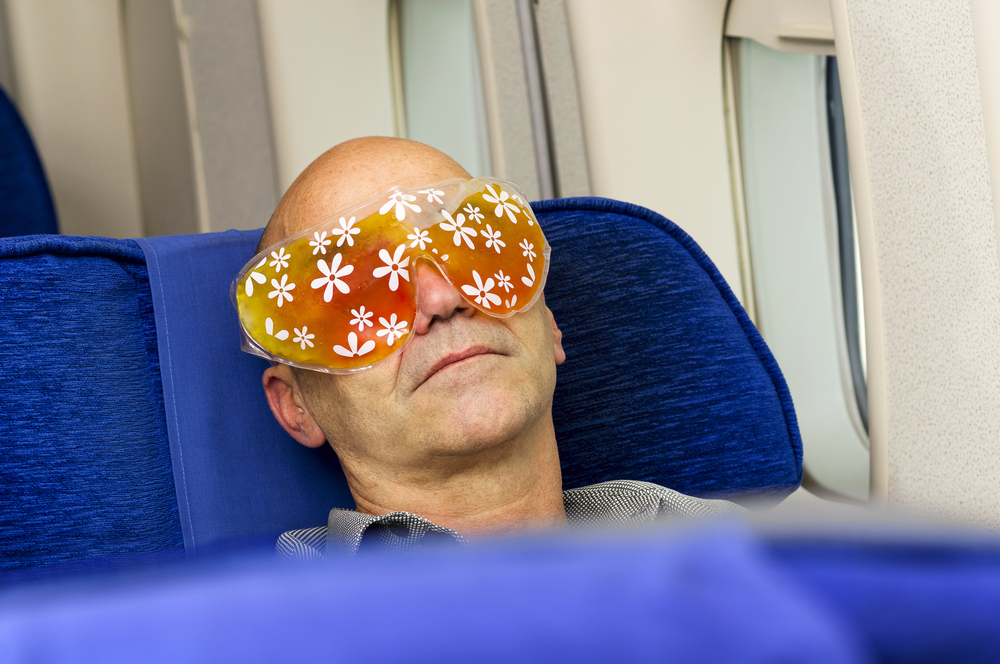
25 Oct Top Tips for Actually Sleeping on a Plane
Sleeping on a plane may be one of the toughest challenges you ever face. But it’s an important one to conquer. A long flight without rest can mean exhaustion for days once you arrive at your destination. That’s on top of the jet lag you’ll be dealing with as well.
Follow the below tips for a better chance of getting some Z’s while in the air.
Booking your trip
Savvy timing of your flight can help you sleep better. Flying in the evening will make it easier to drift off. Match your normal sleep patterns to flight timing when you can. Choosing less popular days (Tuesday and Wednesday) may also increase your chances of getting an entire row to yourself – the jackpot for seasoned plane sleepers. Another way to increase your odds of that: check if there are any open rows the day of your flight, and rebook your seat if so.
Also book a non-stop if possible. You won’t get as deep a rest if you’re waking up every few hours to change planes.
Which seat to select?
Go for a window seat. You won’t be bothered by the comings and goings of your seatmates. You can cozy up next to the window. And you control the window shade.
Some people love the exit row because they can stretch their legs. But some avoid it because most seats don’t recline. Pushing your seat back is important because it relieves pressure on your lower back. That makes it easier to fall asleep.
Stretching out your legs will make you more comfortable. It’s also better for your circulation. Use your carry-on as a foot rest. Keep your legs uncrossed (also better for circulation) and bend your knees slightly.
Avoid booking a seat near busy zones: the bathrooms and flight attendant areas.
Train in advance
If you’re flying east, start going to bed and waking up 30 to 60 minutes earlier than normal a few days before your trip. Going west? Avoid light during the last half of your flight. These tricks will shift your circadian rhythm and align it better with the time at your destination.
As well, handle pre-trip details well in advance of your departure. Stressing about getting to the airport or packing the night before will hurt your chances of drifting off to sleep.
sleeping on a plane: shawl, neck pillow, sleep mask, and earplugs
Pack these four essentials for sleeping on a plane: a wrap or blanket, pillow, mask and earplugs
Pack props
The four essentials of sleeping on a plane: a pillow, eye mask, earplugs and blanket. Your airline may not provide any, and even if it does, many prefer using their own.
Some travelers love the space-saving inflatable pillows. Others are devoted to horseshoe-shaped pillows. You can wear the pillow with the space in front of or behind your neck. Some like the added head support under their chin with the space in back.
Others make do with the airline-provided variety. Even if you bring your own pillow, the airline’s can come in handy as back support (as can a folded jacket). Lumbar support is important for sleeping on a plane.
The eye mask helps block light. Even a little streaming in from your neighbor’s seatback screen or tablet can mess with your slumber. Dim your own screens as well. Another advantage of the mask: it’s a clear signal not to engage you in conversation or wake you up.
A baseball cap serves as an alternative (or supplement) to the eye mask. Pulled low over your face, it blocks out light and gives you some privacy.
Noise-canceling headphones are doubly useful. They’ll block out sounds you don’t want. And you can listen to sounds that enhance your sleep. Relaxation music, nature sounds and white noise will encourage drowsiness. Some fliers even insert earplugs and cover them with headphones for two layers of defense.
A blanket will keep you warm when temperatures drop on board. Buckle your seat belt over your blanket. If there’s turbulence, the flight attendant won’t need to wake you up to check that you’re secured.
Another prop to consider: a familiar item that relaxes you. It might be a soft wrap or cherished sweater. You want to make yourself at home. Well, as much as possible.
Dress for comfort
Best for sleeping: Loose-fitting garments that have some stretch to them. You may want to bring cozy sleep garb on the plane with you and change just before bedtime. Some people don their softest sweatpants or even a favorite pair of pajamas.
You’ll want to bring layers on board, as the temperature in flight can shift rapidly from too hot to too cold. Either extreme will hamper your sleep.
Don’t forget your feet. Consider wearing loose-fitting shoes, as feet swell in flight. Or opt for slip-on shoes, so you can change into something more comfortable. Warm socks or slippers are good choices.
sleeping on a plane: Woman in mask sleeps during night flight with other passengers around her
A dark cabin, reclining seat and sleep mask will help you drift off to slumber in flight
Consider aids
Lavender is a natural slumber aid. Before bedtime, put a few drops of lavender aromatherapy oil on your sleep mask, pillow, temples and wrists. A study found breathing it in before and during sleep decreases blood pressure and encourages deeper slumber.
Many seasoned travelers swear by melatonin. It’s a natural hormone that regulates our sleep cycles. Take it after dark the day you travel, and for a few days after arrival.
If you want a more conventional sleep aid, think about over-the-counter or prescription medications. Two cautions, though: Don’t try a new medication for the first time in flight, as you want to know how it will affect you. And talk to your doctor about what medication is best to use for sleeping on a plane.
Hydrate
Drink water – but not so much that you’ll wake up to visit the toilet. Avoid alcohol, as it dehydrates you. It might help you fall asleep at first, but you’ll likely wake up a few hours later. Getting back to sleep will be more difficult.
Of course, you’ll want to avoid caffeine as well. In lieu of that, bring a bag of your favorite herbal tea. Anything with chamomile will encourage sleep.
Don’t eat too much
It’s best not to eat within two hours of the time you want to fall asleep. When you dine, avoid large meals, or ones with fatty or spicy foods. Aim for a light meal of foods that are easy to digest. Think fruits, vegetables, yogurt and nuts.
Shift your thinking
You’ve probably experienced this many a time. If you obsess over falling asleep, you won’t be able to. The added pressure will wind up keeping you awake. Tell yourself you’re just relaxing, and sleep will come easier than if you try to force it.
Seek expert advice for sleeping on a plane
Travel advisors can offer you a wealth of tips drawn from their personal experiences. Ask about their tricks for sleeping on a plane – then follow their advice.
If you don’t have an advisor already, you can find one that’s a great match for your travel needs at virtuoso.com.


No Comments